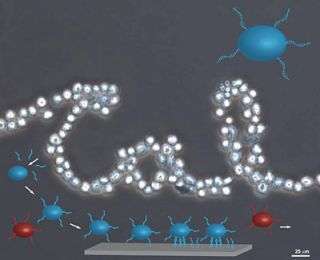Move over, Cal Band! The marching cells are here

The University of California Marching Band's precision formations have new competition – a group of tiny cells altered by UC Berkeley chemists to spell out "Cal" in the one-millimeter field of a microscope slide.
"The world's smallest living Cal fans," according to chemistry professor Richard Mathies, are a fun demonstration of a technique he developed with colleagues Carolyn Bertozzi and Matthew Francis to precisely position cells for study in a microscopic chemistry "lab-on-a-chip."
The cover photo of the November issue of the journal Lab on a Chip shows human cells, each about 20 microns or a fiftieth of a millimeter wide, that were decorated with modified sugars that are in turn linked to specific DNA tags.
Mathies, who encouraged graduate students Erik Douglas and Ravi Chandra to chemically demonstrate their Cal spirit, hopes to use the technique to attach cells to electrodes that then can stimulate the cells and detect their responses.
The cartoon around the Cal formation above shows how cells decorated with DNA tags (blue) attach to short pieces of complementary capture DNA on the slide and are immobilized, while cells that don't attach (red) can be washed away.
Source: UC Berkeley

















